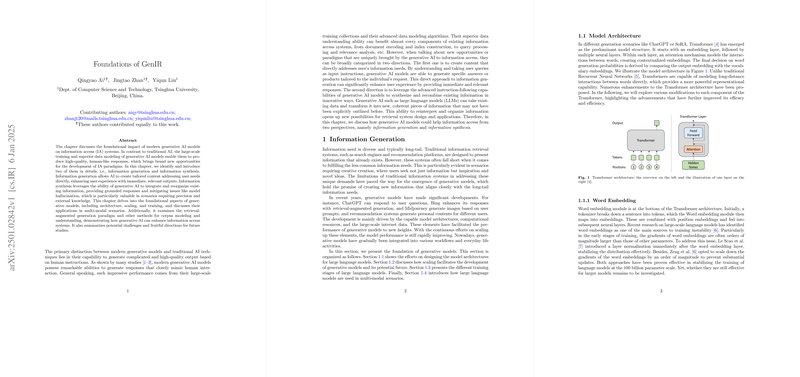An Analysis of "Foundations of GenIR"
The document "Foundations of GenIR" provides an in-depth examination of the transformative impact modern generative AI models have on information access (IA) systems. The authors identify two primary paradigms introduced by generative AI models that diverge from traditional AI techniques: information generation and information synthesis. This paper elucidates the structural and functional components of these paradigms, proposing a forward-looking perspective on their applications and challenges within the IA landscape.
Key Contributions and Frameworks
- Information Generation:
- Generative models enable on-the-fly content creation tailored to user needs, enhancing user experiences through immediate and relevant responses. The paper differentiates this approach from traditional IR systems, which primarily serve existing content rather than generating novel outputs.
- The impressive capability of models such as ChatGPT and Midjourney is anchored in architectural advancements, extensive computational resources, and large-scale datasets. The authors discuss model architectures like Transformers, scaling laws, and training objectives, thereby establishing a comprehensive framework for understanding how these models operate at scale.
- Information Synthesis:
- Generative AI is harnessed to integrate and reorganize pre-existing data to produce reliable, contextually grounded responses. This is critical for scenarios demanding high precision and extensive external knowledge.
- A key aspect explored is Retrieval-Augmented Generation (RAG), a paradigm that involves enriching generative models with retrieved external data to mitigate issues like model hallucination and to enhance the factual accuracy of outputs.
- Models and Techniques:
- The paper explores the technical innovations underpinning modern generative AI, including transformer architectures and their position and attention mechanisms that facilitate complex data modeling.
- Scaling laws are examined, providing insight into how model performance is influenced by size and training data. The implications of these scaling laws are significant, offering guidance on resource allocation for training deep learning models.
- Challenges and Future Directions:
- The document recognizes persistent challenges such as hallucination, the need for handling long contexts efficiently, and stability during the training of large models.
- It also identifies pragmatic challenges like inference costs and the necessity for models to maintain or improve efficiency as they scale.
- The potential for RAG to evolve to handle more complex information synthesis tasks, such as multi-source retrieval and task-specific adaptations, is an area highlighted for further research.
Implications and Speculations
The research encapsulates the potential for generative AI to redefine information retrieval paradigms by focusing on the seamless interplay between generation and retrieval processes. The rise of frameworks like RAG underscores a future where AI systems are not only reactive but also proactive in managing knowledge-intensive operations. The implications for real-world applications are substantial, ranging from improving search engine features to creating advanced conversational agents capable of synthesizing information across various domains.
In speculative terms, the document suggests a trajectory where AI systems become increasingly autonomous, capable of performing complex, multi-faceted operations that integrate both generated and retrieved data. This aligns with broader AI trends toward systems that can reason, plan, and execute tasks with high degrees of independence and accuracy.
The paper presented by Ai et al. is seminal in its delineation of the foundational aspects upon which future research and applications in generative AI and information retrieval can be built. It prompts an exploration of how these models can be further refined and integrated into existing technological frameworks to enhance their utility and effectiveness.
